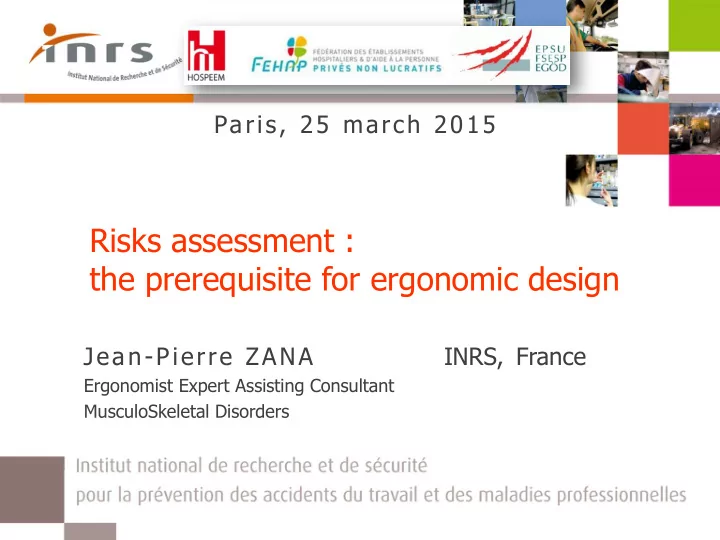

Paris, 25 march 2015 Risks assessment : the prerequisite for ergonomic design Jean-Pierre ZANA INRS, France Ergonomist Expert Assisting Consultant MusculoSkeletal Disorders
Health and social sector in France… 1.1 million of caregivers in public and private Hospitals and care facilities, ¾ in publics facilities 23% in part time jobs ; 78% are women This is in the lucrative private sector that employment was the more dynamic. The decrease in non-profit private sector is related to the redefinition of the scope of hospital activities introduced by the revision of the classification of French activities from 2007.
Health and safety at work Healthcare workers are exposed to high work-related physical stress which combines many risk factors of locomotor apparatus disorders. Patient handling is an especially stressful task, as much mentally as physically. Preventive responses most often made to caregivers are too often "gestures and postures training" type to reduce these occupational hazards.
Obstacle to prevention Lack specific knowledge of equipment manufacturers,… Performance pressure to which companies, especially SMEs,… For managers, OSH is expensive and complex,… The doubt about and a lack of recognition of the fact that prevention is worthwhile in order to : prevent accidents, preserve health save money
The safety of care culture: from concept to practice (HAS - 2010)
Basic principles for the prevention of back pain during patient handling ISSA recommendations 2012 - analyze and assess each situation from the point of view of physical constraints, - give priority to the safety of the patient and care worker, - use handling aids, - mobilize the patient’s own resources - Maintaining caregivers expertise (know-how) - wear appropriate clothing and footwear
The main lines of prevention approach for healthcare sector 1. SCREENING DIAGNOSIS 2. TRAINING REFERENTS 3. WORKING GROUP WITH PROJECT APPROACH 4. DEPLOYMENT STAGE 5. Acquired assessment
The developing prevention approach The proposed approach is based on the recommendations of the technical report ISO TR 12296. Two methods are necessary MAPO Index developed by teams Italian EPM (ergonomics posture and movement) It is a method for analyzing the work conditions organization and layout, adapted to managers of care units. Method for analyzing the physical workload developed by INRS.
Method MAPO MAPO index to comfort the requirement of organization analysis Considers interaction of factors It considers the different factors in an integrated manner and analysis of a ward, needs with a short evaluation time, MAPO Index is calculated considering in an integrated manner the organizational issues, type of patients, type of handling, use of equipment (if available), operators training to specific risk and handling environment.
Physical workload analysis method SCOPE The method was conceived to be used by companies of all sizes and relates to the work activity of an adult population without restriction of aptitude. It applies to a workstation, a workshop, a service, a care unit, … . It is addressed to continuous or intermittent activities, even of very short duration and with strong intensity.
Method of physical workload analysis Overall diagram of the method Phase 1: Location and hierarchy of physical workload in 2 stages with a checklist of 5 indicators Phase 2: Analyze physical workload (5 indicators) Phase 3: Search for tracks of prevention Phase 4: Evaluation of the actions
Phase 1 : Identification checklist
Phase 2 : Physical efforts En références aux normes Françaises, Européennes et Internationales en ergonomie
Phase 3 : Tracks of prévention According to 3 generic axes: Vigilance points in design in exploitation The expected: Development of action plans, Definition of the means to implement
Vigilance points of reference An improvement on an indicator should not degrade some anothers, • The training of the employees follows the technical and organizational • evolutions, The perception of caregivers of their environment (efforts, autonomy, • schedules, aids equipments, medicals beds…) is regularly listened and questioned; The choice of adjustable materials takes account of the individuals • variations. The workwears are adapted to the situation and the employees, are • accepted, maintained and checked; The maintenance and the quality of the equipment and the grounds • are provided; The peaks of activity are anticipated and adapted times of recovery; • Working conditions (loads, daily tonnage, peak of activity, obstructions, • quality of the containers, wearing of PPE…) are followed and their prevented drifts; Communication guides all actions of prevention. •
Phase 4 : Evaluation of actions Actions assessment Controls average Impact on the company Balance and perspective Expected: Report of reduction of the physical workload.
With all my thanks for your attention To transmit is the condition of progress Homage to all those which make me doubt each day jean-pierre.zana@inrs.fr 02/04/2015 17 17 INRS Presentation INRS Presentation
Recommend
More recommend